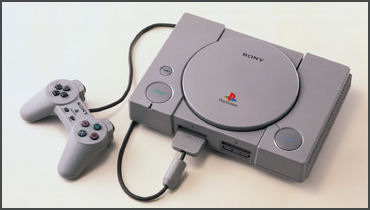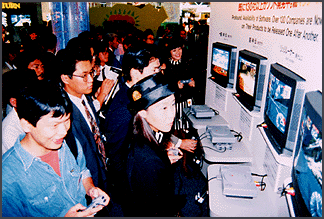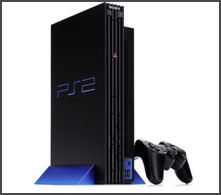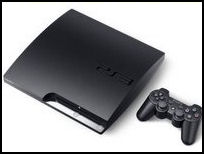SONY VIDEO GAMES

PlayStation Sony was a late arrival in the video game business. The company brass regarded Sony as strictly an audiovisual company and regarded entrance into the "game and toy" market as embarrassing.
The success of Sony’s game consoles have been credited to Ken Kutaragi, a former engineer and the CEO of Sony Computer Entertainment and the “the father of the Playstation.” He was the one that convinced Sony to go into gaming alone after a deal with Nintendo fell through. He assembled a team that developed PlayStation from scratch in the 1990s. His team outdid itself with PlayStation II, which was made with components made from scratch (in the past consoles were made with off the shelf parts).
Good Websites: Sony Computer Entertainment www.scei.co.jp ; Sony.com www.sony.com ;Japan Video Games japanvideogames.com ; Wikipedia article on Sony Computer Entertainment Wikipedia ; Offical PlayStation site us.playstation.com ; Sony’s wii latimesblogs.latimes.com
Links in this Website: SPORTS AND RECREATION IN JAPAN (Click Sports, Recreation, Pets ) Factsanddetails.com/Japan ; BICYCLES, HORSES, BOATS AND GAMBLING IN JAPAN Factsanddetails.com/Japan ; PACHINKO Factsanddetails.com/Japan ; GAMES IN JAPAN Factsanddetails.com/Japan ; TOYS IN JAPAN Factsanddetails.com/Japan ; VIDEO GAMES IN JAPAN Factsanddetails.com/Japan ; SONY VIDEO GAMES Factsanddetails.com/Japan ; NINTENDO Factsanddetails.com/Japan
Sony PlayStation

checking out Play Station in 1994 PlayStation and its sequel Playstation2 were invented by a team led by Kutaragi. Sony's success was based in part on the wooing of independent games designers, who were tired of being manipulated by Nintendo. PlayStation sold well and games played on it sold well.
Sony PlayStation was launched in 1994. It was introduced to compete with Nintendo’s Super Famicon, which had debuted only weeks before. The irony is that Sony developed the game console after Nintendo pulled out of a joint venture.
In 1998 PlayStation1 earned Sony $5 billion and 40 percent of its profits. By 2000 one in every four U.S. households had one. The 100 millionth PlayStation was shipped in May 2004. Of these about 70 million were PlayStation2s But by that time sales had slowed to a point that Sony’s net income was hurt.
Sony PlayStation2

PlayStation 2 Sony's Playstation2 was one of the most anticipated products ever made. Retailing for $300 and applauded for it stunning graphics, it was a combination video game, DVD and CD player and personal computer and contained a chip so advanced and fast that U.S. defense officials worried about it falling into the hands of enemies.
The Playstation2 console actually coast more to make ($390 to $440) than it sold for. Sony made money selling the games ($50) and additional hardware like a second controller ($35), memory cards ($35 a piece), a remote for the DVD player ($20) and other stuff. Sony also sold digital cameras and printers designed work with the multimedia machine. In late 2003, the price dropped to $250.
Playstation2 was introduced in Japan in March 2000. Huge crowds waited outside stores, anxious to get their hands on one, and one million units sold out in less than 48 hours. An American, explaining why he was waiting in line in Tokyo for a Playstation2, said, "In gaming terms, this is up there with the invention of the steam engine." Playstation2 debuted in the United States in October 2000. Lower than expected quantities were sold because of a delay in the delivery of key components. The initial supply of 500,000 sold out in hours and many people who wanted a unit for Christmas had to wait until the following spring.Playstation2 debuted in Europe in November 2000. Rowdy crowds lined up and jostled for space outside Paris department store that began selling at midnight at the start of the European launch.
After the initial rush, sales leveled off. Playstation2 games contained impressive graphics but were no more fun to play than the old games. Sony was criticized for creating technology that was too complicated to make games for and not being accommodating to independent game makers as it had done with Playstation1. The cost of producing a games for Playstation2 was $5 million to $10 million, compared to $800,000 to $1.7 million for Playstation1. Sony was initially unable to make big profits by selling games. There was also an embarrassing recall and production delays.
Sony recovered from early mistakes. By May 2001, Playstation2 had sold 3 million units in the United States and 10 million around the world and a third of U.S. households contained a Playstation1 or Playstation2. As of 2003, 17.9 million PlayStation units had been sold, compared to 8.4 million for Microsoft’s Xbox and 6.4 million for Nintendo’s GameCube. As of 2007, 41 million Playstation 2 units worldwide. PSX was Play Station II’s successor
PlayStation Portable

advanced PlayStation Portable In May 2003, Sony announced it entrance into the portable game market with a portable device intended to directly challenge Nintendo’s Game Boy. It also announced a deal with Electronic Arts Co., the industry’s top game publisher, to make on-line games, a challenge to Microsoft which had similar plans.
Sony’s PlayStation Portable (PSP) game console and music and movie player sold out quickly after its debut on Tokyo in December 2004. In some places more than 1,000 people waited in line for stores selling it to open. Some waited all night, The PlayStation Portable was introduced in the United States in March 2005.
The PSP has 3-D graphics adopted from PlayStation2, good quality music and movie capability the best picture quality of any handheld game device. Not only can it be use to play games it can be used to watch films, listen to music, surf the Web and chat online. It also boast impressive vitals: a wide screen display that shows more than 16 million colors and chips as powerful as those used in PlayStation.
PSP was Sony’s first entry in the hand held market, traditionally dominated by Nintendo. It initially sold for $189 and was released 10 days after Nintendo released its DS portable player. Sony sold 1.95 million Playstation Portables in 2005, compared to 7.53 million DS units sold by Nintendo.
A new lighter, slimmer Play Station Portable was introduced in Japan in September 2007. It had a number of new features, twice the memory and sold 1 million units in two months. A newer PSP was introduced in October 2008 with an advanced liquid crystal display and the ability to receive “one-seg” television broadcasts and be used as a mobile extension to PlayStation 3.
In June 2009, Sony launched the PSP Go, which uses a flash drive instead os storage hardware and is 50 percent smaller and 40 percent lighter that the PSP. It was designed to compete against Nintendo’s DS and Apple’s iPhone and iPod Touch.
Sony introduced the PSP Go in 2009. It had so many features — including an Internet browser, a Skype connection and Bluetooth capabilities — it seemed like was devised to compete with Apple’s iPhone not Nintendo’s DS. Some retailers were reluctant to carry it because it used downloaded games rather than ones purchased through a retailer.
PlayStation3

PlayStation 3 Slim Playstation3 went in sale in November 2006 in Japan and the United States. The lines waiting to buy were unruly. There were stabbings, shootings, hold ups and beatings linked to the release. One man was badly beaten after being robbed of a new Playstaion3 he had just bought. The police in some places had to be called in to quiet the crowds waiting on line to buy it. Many potential customers went home empty handed because of a shortage of supplies. Some of those who got their hands on them resold them for a tidy profit. After getting his hands on one a Tokyo gamer said, “I’ll play it all through the weekend. No time for meals.”
Playstation3 has high-definition graphics and broadband connectivity and more combined processing power than Xbox, GameCube and PlayStation2 combined. It is powered by the Cell chip which was developed by Sony, IBM and Toshiba and features Blue-ray DVD technology. The prices was slashed by nearly ¥13,000 to ¥49,980 so it could compete with Nintendo’s Wii and Microsoft’s XBox360
Playstation 3 and Nintendo’s Wii were launched around the same time. PlayStation 3 trailed badly behind Nintendo’s Wii after its release. In this first month after Playstation3 was released it sold 470,000 units in Japan, compared to 990,000 units for Wii. One clear reason Playstation3 didn’t do so well is the price. It cost twice as much Wii. People also complained about the lack of games that could be played on it.

Playstation 4 prototypes In 2006, in the United States Xbox 360 outsold Wii which outsold Playstation3 but surprisingly all of these were outsold by Playstation2, which analysts said showed the importance of low prices. In the month of December 2006, Xbox 360, which sells for between $299 and $399, sold 1.1 million units; Wii, , which sells for $249, sold 604,000; Playstation3, which sells for $499 or $599, sold 491,000 and Playstation2, which sells for $129, sold 1.4 million Playstion2. .
In 2007, Sony lowered the price of Playstation3 to around $400, introduced slimmed-down version and reduced prices for software development from around $10,000 to $5,000 to encourage gaming companies to make games for the device. Sales of the Playstation tripled in the United States at the end of 2007 after the price cut, finally outselling Nintendo’s Wii
In 2007, Sony sold 3.97 millon Playstation2s and 2.56 million Playstaion3s. Playstation2 sales were boosted by the high price of Playstaion3 and the fact that Nintendo Wii’s were hard to get. About 10.5 million Playstation3s had been sold as of April 2008.
In October 2008, Sony introduced an 8-gigabyte Playstation3 that sold for about $400. At the end of 2008, Sony launched a “PlayStation Home” virtual-world service that allows users to play games and chat through game characters. PlayStation Networks, an online service that lets users play games online and surf the Internet, was made available to PlayStation 3 and PlayStation portable users. As of 2008, Sony was still negotiating with Hollywood studios on distributing movies online using Playstation3.
In August 2009, Sony introduced a revamped, slimmer version of PlayStation 3 whose cost was slashed $100 to $299. In October 2010, Sony slashed the price of the Playstation Go from ¥26,800 to ¥16,800 on the eve of the holiday shopping season.
In August 2011, Sony said that it will slash the price of PlayStation 3 by ¥5,000 from ¥29,980 to ¥24,980 before the Christmas-New-Year shopping season. Analysts said the move in part was a response to competition from Microsoft’s Xbox. As of August 2011, Sony had sold 52 million PlayStation 3's while Microsoft had sold 55 million of its rival Xbox 360.
New PlayStations and Stuff
In 2010, Sony unveiled the Playstation “Move” — which employs a wandlike device similar to one found in Nintendo’s Wii, except it has a glowing bulb attached to one end, which simulates everything from a tennis racket to a baseball bat. Sony claims the device is much more precise and flexible than the Wii controller, capturing every twitch and contraction of the arm and hand. It also features a number of buttons to provide even more options.
The “Move” is being promoted with the Playstation “Eve,” a device that resembles a webcam that puts a user’s image on the screen. Describing the game “ Me and My Pet “, which uses both devices, Tom Bake wrote in the Daily Yomiuri, “As she sat in the floor in front of TV, the Eye put her image on the screen — and kept it there. As the game began, an animated image of a cute monkey-kitten creature appeared next to the live image of the player. She moved her controller to move tools, such as a showerhead and a hair dryer, that she used to wash and groom her furry pet, which reacted with pleasure to her attention. As she gave it a shower, the screen even steamed up a bit.” The Move and Eye went in sale in October 2010 separately or as part of $70 package that includes the drawing game “ beat Sketch! “.
Sony now offers several Blue Ray 3-D discs for PlayStation 3 that includes versions of sports, racing and fighting that pop out the screen.
The most popular games, which can be obtained online, include “ Everquest “, “ Free Realms “ and “ DC Universe Online “.
In March 2011, customs in the Netherlands seized 300,000 Sony Playstations as part of a patent complaint by LG Electronics. A Dutch court ordered the released of the consoles in what appeared to be the first battle of a long war.
In February 2011, Sony-Ericsson launched a smartphone that plays PlayStation games. The Xperia Play phon, unveiled at a Sony Ericsson event in Barcelona, has a relatively big touch screen and a pad that slides out to reveal control buttons similar to those in a Sony Playstation Portable. It operates using the Google Android system and is marketed by Verizon in the United States.
Sony Corp Unveils the Vita, New Handheld Gaming Device
In June 2011, AP reported, “Sony unveiled its next generation portable gaming machine, PlayStation Vita, a touch-interface and motion-sensitive handheld that outdoes its workhorse PlayStation Portable and will go on sale before the winter holidays. Company executives called the device Sony's biggest product launch since the PlayStation 3 five years ago.” [Source: AP, June 7, 2011]
Unveiled at the Electronic Entertainment Expo in Los Angeles, the device will allow gamers to be connected with one another over cellphone networks and Wi-Fi hotspots, and use GPS location-tracking technology. In the U.S., Sony is partnering exclusively with AT&T Inc. for cellphone service. The Wi-Fi-only version will sell for $249 in the United States. A version that will also have cellphone service will retail for $299 US, and buyers will have to subscribe to a cellular data plan.
“The handheld device has front and back cameras, a touchscreen in front, a touch pad on the back and two knob-like joysticks. It will enable gamers to play against people using PlayStation 3 consoles over the internet-based PlayStation Network. Sony apologized again for the outage and said since the network was restored, activity is back to 90 per cent of the pre-attack level. The hardware comes with an accelerometer, which means it will also react to being held at different angles and being moved through the air.” "PlayStation Vita will revolutionize the portable entertainment experience," Kazuo Hirai, group chief executive officer of Sony Computer Entertainment Inc., told a crowd of 6,000 at the Los Angeles Memorial Sports Arena. "The whole world is really in play."
“The Vita is slightly bigger than the PlayStation Portable, which has sold more than 70 million units worldwide since its launch in 2004. The PSP will continue to be sold along with new games. But the Vita — code-named "NGP," or next generation portable — will enable gamers to do more. A game called Reality Fighters will allow users to take a picture and have fighting characters battle each other using objects from the real world. Along with social games and email, Sony also unveiled a communication service it called "Party" that will enable voice and text chat during games or when using the web browser. Users will also be able to sense when other gamers are nearby, what games they have played recently, and enable in-game gifting of virtual items.”
In January 2011, Reuters reported, Sony first unveiled the devise, which the media described as Sony’s answer to competition from smartphones and tablets and Nintendo’s latest DS. Sony at that time said new the "NGP" devise will use a 5-inch OLED panel, significantly larger than 3.5-inch standard smartphone screen. [Source: Reuters, January 2011]
The Vita handheld device will go on sale in Japan in December 2011. It will cost $249 in the U.S., and 24,980 yen in Japan, for a Wi-Fi only version, and $299 and 29,980 yen for a version that will also have a cellphone service.
Sony's PSP has sold some 61 million. The next-generation PSP may be closely related to a PlayStation.
In June 2011, Sony announced plans to begin selling a handheld, 3D-enabled games device for $299 -- which critics immediately deemed too pricey.
PS Vita versus Smartphones
In December 2011, The Yomiuri Shimbun reported: “The world of computer games has entered a new kind of war, with Sony releasing a handheld gaming device with increased network functionality in a bid to compete with popular smartphone games. For many years, competition in the video game industry was primarily between Sony's computer game division and game giant Nintendo Co. However the proliferation of smartphones led to a rapid increase in the popularity of game software for mobile phones. As a result, competition between game producers to recruit talented developers is heating up. [Source: Yomiuri Shimbun, December 18, 2011]
Sony released its PlayStation Vita handheld video game console, which allows users to play with anyone in the world using cell phone lines. The Vita's display resolution is four times higher than that of PlayStation Portable models. Its network functions have also been given a boost, enabling users to access Twitter, Facebook and other websites via third-generation cell phone lines.
Sales of devices used exclusively to play video games no longer enjoy the momentum they did in the past. According to gaming magazine publisher Enterbrain Inc., the market for home-use video game consoles, including both handheld devices and standalones, fell by about 30 percent in 2010 from 2007, when sales peaked at about 688 billion yen. In contrast, the market for online games for mobile phones hit about 320 billion yen in 2010, double what it was four years previously.
Along with the proliferation of smartphones, which have larger display screens than cell phones, a growing number of people are playing games on social networking sites, with most titles exclusive to mobile phones. In SNS games, people who have never met can play games in match or cooperative mode. Sony's older PSP models had no function to access networks via mobile phone lines, and consequently their online features were lacking.
While the Vita device has the telecommunication function, only 24 game titles were available at the time of its release. Though Sony plans to add titles to its lineup of games for the Vita device, it cannot compete with the 100,000 or more titles available on the iPhone smartphone by the U.S. company Apple Inc. Enterbrain President Hirokazu Hamamura said the Vita's success will "depend on how many new, exciting and easy-to-play games will be provided.”
Sony Games
In 2002, 430,000 subscribers paid $12.95 to play Sony’s “Everquest”, a medieval role-playing game played on the Internet against other online players.
In the mid 2000s, Sony apologized to the Anglican Church over a video game — “Resistance: Fall of Man” — that shows a bloody shoot out between an American soldier and aliens in an Anglican Cathedral.
“Echochrine” is a game that features a doll-like figure that walks through minimalist line drawing in which pathways become possible or impossible depending on the angle in which the scenes is viewed. It was inspired by the art of M.C. Escher.
In August 2011, Sony purchased the Washington-state-based developer Sucker Punch Productions as part of an effort to develop new software for its PlayStation game. In July the company it was creating a $20 million fun to give money to game-making companies to develop unique games for PlayStation Network. The aim is to lure Playstaion 3 users to Sony’s online games. In September bought Redmond-Washington-based Micronics health products, the company’s first purchase of medical equipment manufacturer.
Image Sources: Sony except PlayStation 3 (Sony Guru)
Text Sources: New York Times, Washington Post, Los Angeles Times, Daily Yomiuri, Times of London, Japan National Tourist Organization (JNTO), National Geographic, The New Yorker, Time, Newsweek, Reuters, AP, Lonely Planet Guides, Compton’s Encyclopedia and various books and other publications.
Last updated January 2013
